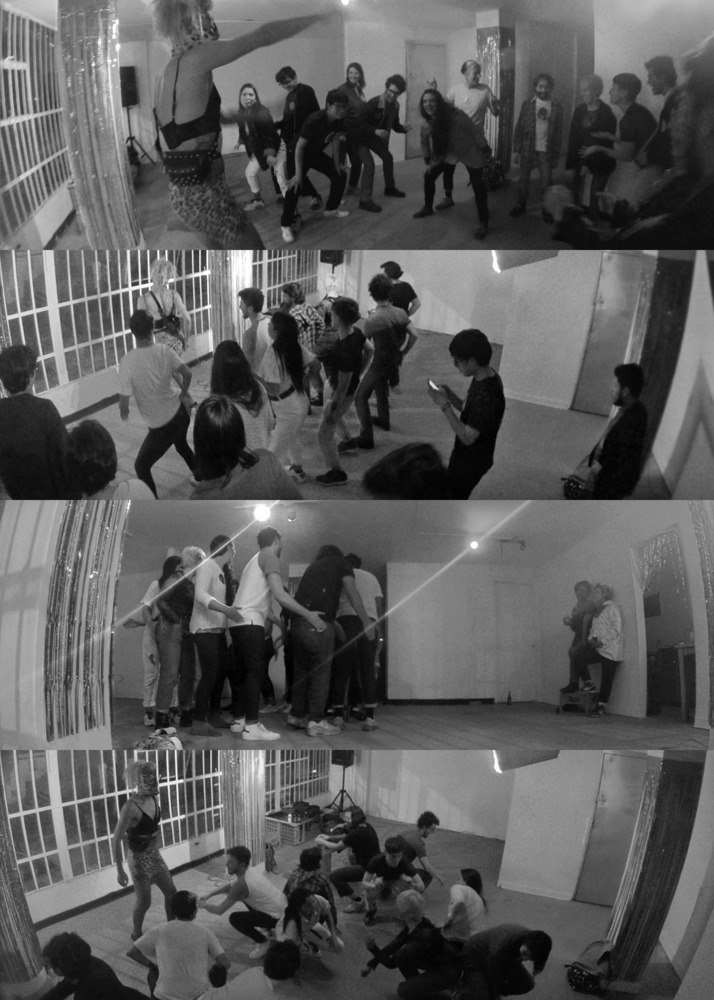
ESTO NO ES UNA FIESTA SEMÁFORO (THIS IS NOT A TRAFFIC LIGHT PARTY)
first performed on September 27, 2019
LA EN BAJADA, Bogotá, Colombia
performed once in 2019
ANA IZQUIERDO
Lima, Peru
214350667a214350667n214350667a214350667z214350667e214350667.214350667i214350667z214350667q214350667u214350667i214350667e214350667r214350667d214350667o214350667.214350667a214350667z214350667o214350667r214350667i214350667n214350667@214350667g214350667m214350667a214350667i214350667l214350667.214350667c214350667o214350667m
Juan Escobar a.k.a Honey Vergony
ESTO NO ES UNA FIESTA SEMÁFORO (THIS IS NOT A TRAFFIC LIGHT PARTY)
ANA IZQUIERDO
In this performance, Izquierdo proposed an exercise of reflection on corporealities and the agents that operate on them. “Esto no es una fiesta semáforo” prepares a meeting where desire and bodies are placed at the center of a discussion to understand the ways in which they manifest, enroll, and normalize. Traffic light parties are popular, clandestine parties famous in South America. Part of the reason they are forbidden is because of the sexual connotation they can have in regards to the color one chooses to wear: red = just came to watch, yellow = I can flirt, green (and in this case blue) = I’m open to everything. In “Esto no es una Fiesta Semáforo,” stickers of different colors (red, blue, and yellow), along with directions from Honey Vergony (Juan Escobar), specified the starting dynamics for physical contact. Honey Vergony, as a trans artist who does drag, is the one who takes the power to give directions. The heteronormative relations between people are erased by the orders and directions given to them in regards to dancing, touching, and relating during the performance. It offers new ways of thinking about the possibility of encounters and the ways in which the bodies operate under a logic that surpasses them.
How are the intensifications of the participants carried out at various types of parties that have ends such as finding a partner, flirting with different people, or going on “mamarre”? To what extent is each participant allowing or negotiating the experience of exercising their interests, or the interests of others and those who dominate? These questions open up conversations about how we can redesign the dynamics of social encounters if we start giving space to different instructions, like in this case.
Izquierdo understands that the body is bio-political (and goes through specific forms of operability), which is why it proposes a staging that seeks to delimit the idea of the “Latin American hemisphere” and its wide range of musical and cultural possibilities. The performance copies the aesthetics of a normal party in latinx culture (music, drinks, food, and topics of conversation). Izquierdo’s proposal is a space that promotes encounters with new logics, interruptions, and re-formulations. The staging of these actions can permit or facilitate other encounters with the excuse of participating in a performance and without having to open up explicitly about the way the body, desire, and dialogues have been socialized or disciplined. Juan Escobar, “Honey Vergony,” proposes exercises where (under consent) participants can openly talk about what the usual social choreography is in spaces of celebration, while also discovering others in a space that excuses certain behaviors through the idea of “art.” The use of grammar and code produces another relationship, another way of enunciating, of acting, of naming towards a new form of relationships between corporealities, desires, and affections.